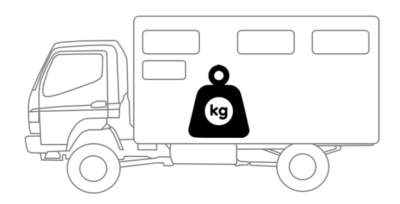
The plan is for Molly to take us and all of our Molly stuff to some of the most remote places in the world. But just how much stuff can we take and just how far can we go? Here we explore these questions in a little detail.
Payload Calculation
Payload is the general term used to measure how much stuff you can safely carry. Available payload is easy to calculate and is the maximum gross vehicle weight rating (GVWR) of the truck less the weight of the truck itself. The GVWR specifies the maximum legal limit the truck can weigh and still remain safe. While the weight of the truck is obviously the weight of the truck, it is worth noting this “truck weight” is measured without people and any stuff (or payload), but does include all required fluids like coolant and transmission oil and with a full fuel tank (fresh, grey and black water tanks are empty and excluded). This truck weight is also known as the curb weight. In our case, we include the weight of the Earthcruiser house and consider all of the bolted down parts of the truck as part of the truck. Of course the house is empty of any food, clothes, camping equipment, toys; basically all of our stuff. With these definitions and calculation, Available Payload is thus a weight measure of all the stuff we can take safely.
All ratings are for a moving or dynamic load, usually on a highway at around 100 kph. The forces exerted on the truck when moving are much higher than when it is sitting still (static load).
Available Payload is a little more complicated than the above description. Not only can the GVWR not be exceeded, but there are also maximum ratings for the front and rear axles. Axle ratings are indicated on the rating sticker with the term, GAWR. Thirdly, there are the tires, they also have a maximum weight rating.
Scott and Matt have an excellent talk about the importance of managing Payload in one of their podcast on Expedition Portal. And Tom Shepard in his Vehicle-dependent Expedition Guide opens the vehicle selection section with a discussion on Payload. The tl:dr summary; Payload considerations are very important.
Gross Vehicle Weight and other Ratings
Let’s start with what the FUSO Canter FG4x4 is rated for in the USA. Here are the specifications from the manufacturer, all of which are maximums:
- GVWR = 14,050 lb. / 6,373 kgs.
- Front GAWR = 5,730 lb. / 2,599 kgs
- Rear GAWR = 9,480 lb. / 4,300 kgs.
The tires also have a maximum weight rating. We have Toyo Open Country M/T tires LT 315/75R16 which have Load/Speed rating of 127Q which converts to 3,858 lbs / 1,750 kgs per tire at 99 mph / 160 kph and at inflation of 65 psi. If you do the math, the ratings of the rear axle weight is limited by the tires.
Earthcruiser has modified the suspension and springs, and have put their own GVW rating sticker on the truck. Earthcruiser knows the vehicle and the tires and their sticker changes the various ratings to
- GVWR = 13,050 lb. / 5,919 kgs.
- Front GAWR = 6,175 lb. / 2,800 kgs
- Rear GAWR = 7,716 lb. / 3,500 kgs.
As a second stage builder, Earthcruiser would have to perform braking tests and other federal certifications to confirm these new ratings.
Available Payload
Now that we know the safe maximums, it is easy to calculate the Available Payload. We just need to establish the truck weight, and this is easy, all we need to do is weigh Molly (unloaded of course). At the time we took ownership of Molly, the truck weight was recorded on the Certificate of Origin as 10,300 lbs / 4,672 kgs. But for good measure, we weighed Molly at a public scale, with the following results
- Vehicle Weight = 11,840 lb. / 5,370 kgs.
- Weight on Front Axle = 5,940 lb. / 2,694 kgs.
- Weight on Rear Axle = 5,900 lb. / 2,676 kgs.
Weight was based on full fuel and DEF tanks, both of us in the car, all the storage boxes that we have added although they were empty. The water tanks which were also empty. Lastly, included was bedding, recover boards and snow chains.
Based on the actual weight, the Available Payload of Molly can be calculated at 1,200 lbs. / 544 kgs. And now all we have to do is to budget for all of our stuff.
Spending the Payload Budget
Our budget includes the following
- Fresh water tanks filled (43.5 + 28 gallons / 270 l)
- Grey water tank filled (20 gallons / 75.7 l)
- Toilet, Black and Flush Water filled (9.1 gallons / 34.3 l)
- Clothes
- Food
- Tools, Spare Parts and Recovery Gear
- Assorted electronics
Without getting into the exact budget amounts, when fully loaded, we are typically below the Payload by about 100 kgs. Staying within ratings just makes sense. Shout-out to Earthcruiser for getting this right.
Range vs Payload
There is a relationship between Range and Payload. More fuel, more fresh water, more food all means more range, but it also consumes part of the available payload, leaving less room for other stuff. Molly has 63 gallons of fuel, giving an approximate range of 750 miles or 1,200 kms. All dependent on the terrain and driving conditions of course. In Sterlin we had a range closer to 300 miles or 500 kms (without our Jerry cans), and never had issues finding fuel. So we do not expect that fuel range will be our limiting factor.
The 70 gallons of freshwater gives us a range of about 2 weeks between water refills, again dependent on the conditions. Could probably stretch it out to 3 weeks if we really needed to. We can certainly carry enough food for 2 or 3 weeks in our payload budget.
Based on the above, there is no need for extra fuel tanks or more storage to extend our range and consume more of our payload.
Fully Loaded
We loaded Molly up with everything we could think of, including things we would not normally take on an extended trip. The fuel tanks and all of the water tanks were topped to the brim and both fridges were packed. And then we weighed Molly at a public scale, with the following results
- Vehicle Weight = 13,060 lb. / 5,923 kgs.
- Weight on Front Axle = 5,640 lb. / 2,558 kgs.
- Weight on Rear Axle = 7,420 lb. / 3,365 kgs.
So, basically fully loaded we are at the maximums. This is good news, this demonstrated to us that it will be hard for us to overload Molly. It seems unlikely that we would be this loaded during an extended Overland trip.
Storage Boxes over the Cab
We decided to add two Alu-box storage boxes to the roof rack above the FUSO cab. Most likely we will use this boxes to store off-season clothes and hiking shoes and equipment. Having a little extra storage seems like a good idea (even at the cost of slightly impacted fuel consumption). The boxes are connected to the roof rack using a K9 Eezi Awn mounting bracket. This allows the boxes to removed without too much hassle.
Having weight up high is never a great idea. So, whatever we put in theses boxes is always very light.


The above extraction gear is only sufficient for a simple single pull recovery. In addition to the above gear we also have 1) kinetic strap from ARB rated at 33,000 lbs MBS, 2) 2x Recovery Rings from 7P rated at 40,465 lbs MBS, 3) 2x 7/8″ Van Beest Screw Pin Shackle rated 85,800 lbs (MBS), 4) 1x 20′ bridle strap from Masterpull rated at 21,500 lbs MBS straight pull (Macgyver). With this additional recovery gear we can setup for a double or triple pull.

